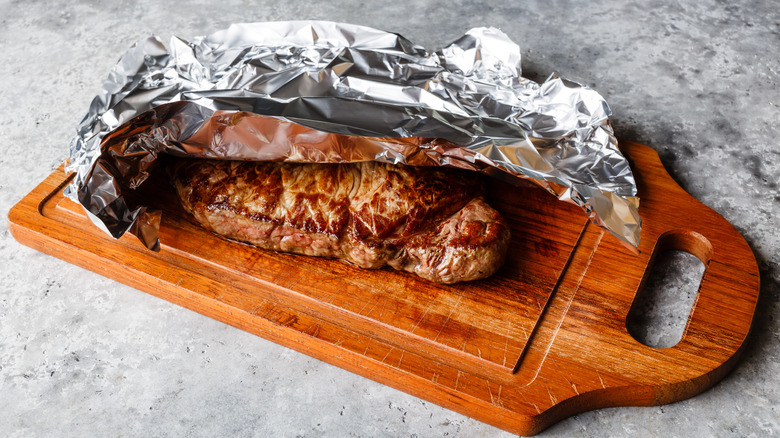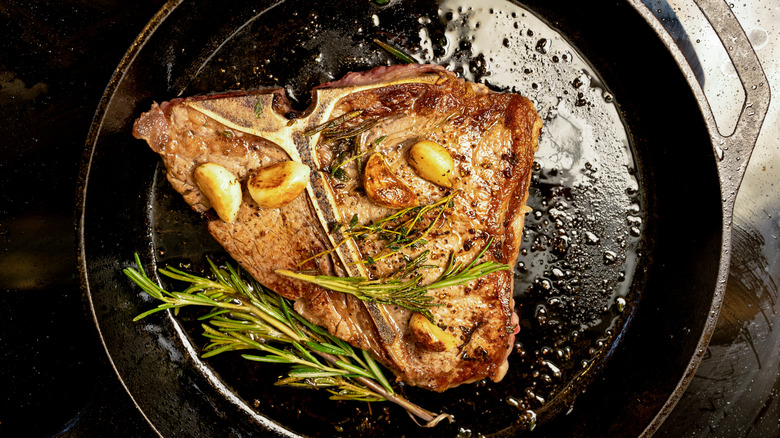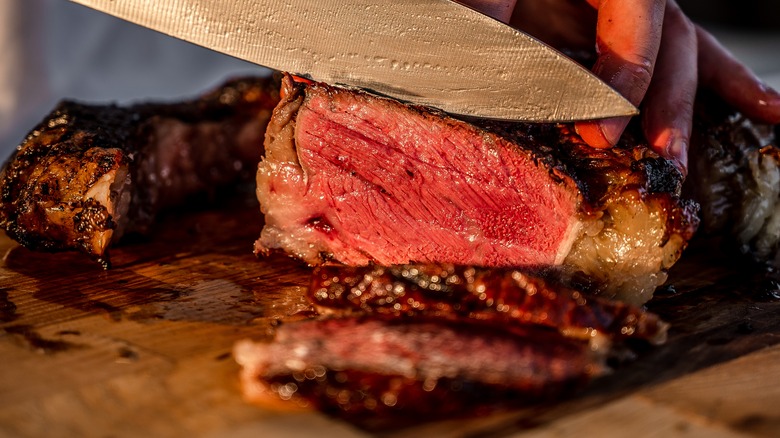Why You Might Want To Think Twice Before Resting Meat Under Foil
Maybe you're team finish-in-the-oven. Perhaps you're team reverse sear. Or maybe you grill, or sous vide and finish in the broiler. Some people even spatchcock their birds. However you cook your meat, if a crispy crust is important, you might want to rethink how you're resting it.
Those who rest their meat care about it being juicy and succulent. For those who take the time to crisp up the crust, there are ways to do it that won't destroy that effort. Most importantly, ditch the aluminum foil.
Not only is foil a terrible insulator, but by tenting or wrapping a plate in it, it's trapping the steam emanating from the meat, creating a humid environment that will soften the crust as it rests. The concern, of course, is that without covering it, the meat will cool during this resting period. The truth is, as long as it is rested properly, it really won't cool that much.
Proper resting to retain a good crust means, first and foremost, not on a cold plate. Not only will this sap heat from the meat, it will create a moisture seal underneath — that swampy, crust-wrecking environment which is to be avoided at all costs. Instead, rest the meat on a cooling rack or wooden cutting board. If it's absolutely necessary to rest on a plate, at least warm the plate first.
How to rescue a softened crust
The "crust" on a piece of meat is formed by the Maillard reaction: Sugars and proteins interact in about twenty to thirty chemical reactions, some of which science has figured out and some of which it still hasn't. In meat, the Maillard reaction begins when the surface of the meat reaches roughly 300 degrees Fahrenheit. It gives a complex flavor and great, crisp texture to meat. As it rests, none of the flavor is lost, but it might remove some of the texture. Fortunately, it can be rescued.
If the crust has softened while resting, re-crisp it immediately before serving. If there are pan juices, heat them to smoking hot and pour them over the meat; the crust will reform. The sizzling, screaming hot fatty liquid will cause the surface of the meat to crisp up again. If using a grill, get it hot again while the meat is resting and then put the meat over the hottest part. Sear for no more than one minute, and then serve immediately. Because this technique is not intended to reheat the interior and it should be served immediately, there's little risk of overcooking the meat.
Why does meat need to be rested, anyway?
Resting meat is a crucial step for a perfectly juicy dinner. When the meat is cooked, the muscle fibers tense and denature, squeezing out moisture. As the meat rests, the juices reabsorb and redistribute, causing a more moist bite. It's all true; tests have shown that rested meat leaks less than unrested meat. But is it actually a redistribution of juices, and is it enough to really be noticeable?
According to a slew of professional chefs and food scientists like Heston Blumenthal, Dr. Greg Blonder, and J. Kenji Lopez-Alt, the amount of liquid lost by not resting meat is generally pretty minimal. Is it enough to notice? Only if the meat is not cooked well — if it's already verging on dry, then every little bit counts. But if it's not overcooked, there's still plenty of juice left over.
Meathead Goldwyn argues that it may actually be carryover cooking and evaporation that causes this difference, not reabsorption. Not resting may get someone into a fight on the internet, but the whole point is a great cut of perfectly cooked meat — which means a crispy crust. So whether resting meat or not, one thing is sure: Don't do it under foil, or the crust will be ruined.


